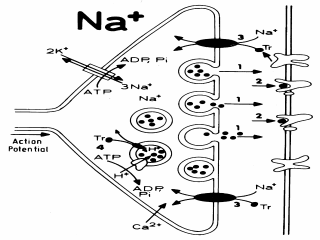 |
Figure
9. Synaptic function in the CNS. At neuromuscular junction,
acetylcholine is released from pre-synaptic cells and binds to the
nicotinic acetylcholine receptor on the muscle cell membrane, thereby
opening a sodium channel which leads to depolarization of the post-synaptic
muscle cell. Subsequently, the signal is terminated by acetylcholine
esterase which hydrolyzes the neurotransmitter, and in addition, the
acetylcholine receptor becomes desensitized. In contrast, at synapses in
the CNS, the primary means of terminating the signal is by re-uptake of
neurotransmitters (e.g., dopamine, serotonin, glutamate, glycine) into the
pre-synaptic cell and subsequent repackaging into synaptic vesicles.
Starting with the synapse at rest, synaptic vesicles loaded with
neurotransmitter (l,
Tr) are concentrated in the axon terminal, and an action potential travels
down the nerve fiber to the axon terminal. Upon depolarization of the axon
terminal, calcium enters and triggers fusion of synaptic vesicles with the
synaptic membrane of the pre-synaptic cell, a process that involves specific
interactions between a number of proteins. At this point, the contents of
the synaptic vesicles (i.e., neurotransmitters) are released into the
synaptic cleft (1) where they diffuse to the post-synaptic cell membrane,
bind specifically to a receptor (2) and open a channel for sodium (with
depolarization of the post-synaptic cell) or chloride (with
hyperpolarization of the post-synaptic cell). In order to terminate the
signal, the neurotransmitter is transported back into the pre-synaptic cells
via neurotransmitter re-uptake proteins that are specific for
different neurotransmitters (3). Transport is usually sodium-coupled, but
frequently, translocation of other ions (K+ or Cl-) is
also required for accumulation. Once inside of the axon terminal, the
neurotransmitters are actively transported and re-packaged in synaptic
vesicles (4). There is a so-called vacuolar ATPase on the outer surface of
the synaptic vesicle membrane that utilizes ATP hydrolysis to pump protons
into the synaptic vesicles, thereby generating a
 (interior
positive and acid, as in ISO E. coli membrane vesicles). The
neurotransmitter is then actively transported into the synaptic vesicles by
means of specific antiporters in the synaptic vesicle membrane (i.e.,
protons move out of the synaptic vesicles down their electrochemical
gradient, and the energy released by this process is used to accumulate
neurotransmitter against a concentration gradient). The synaptic vesicles
in the pre-synaptic axon terminal are now reloaded and ready to release
neurotransmitter again. (interior
positive and acid, as in ISO E. coli membrane vesicles). The
neurotransmitter is then actively transported into the synaptic vesicles by
means of specific antiporters in the synaptic vesicle membrane (i.e.,
protons move out of the synaptic vesicles down their electrochemical
gradient, and the energy released by this process is used to accumulate
neurotransmitter against a concentration gradient). The synaptic vesicles
in the pre-synaptic axon terminal are now reloaded and ready to release
neurotransmitter again.
 |
Go to Comment Form |
|